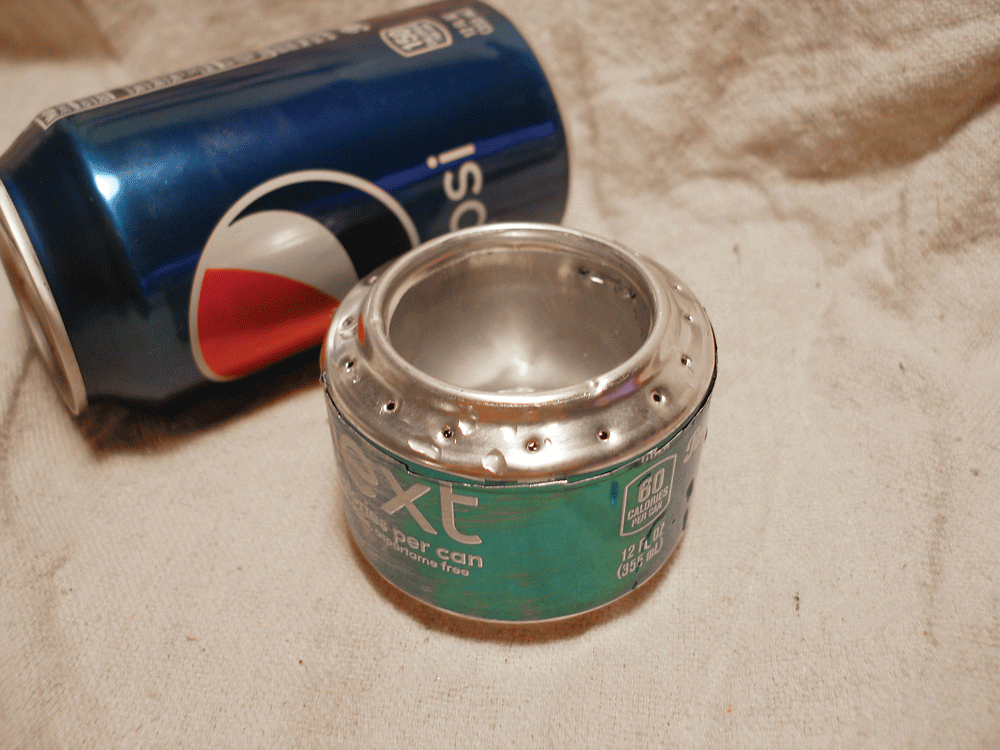There are a number of reasons why you shouldn’t start an open fire: You’re in an enclosed space; you’re trying to conceal the smoke; or you want something you can extinguish quickly and easily, just to name a few. One of the prime reasons a small camp stove is an invaluable tool to your survival is that you have complete control over its flame. It is contained in a small space and, with the proper fuel, will burn efficiently and effectively, cooking, warming, or illuminating.
However, in a survival situation, you might not always have a stove handy, but there is one thing you can count on in today’s society: You find trash everywhere. The likelihood of you stumbling upon a couple of beer or soda cans the day after doomsday is particularly high if you are anywhere near inhabited areas. People are litterbugs, and as a survivalist, you can always use that to your advantage.
Building a small double-walled camp stove out of a couple of aluminum cans is easy and can be done in about 10 minutes with minimal tools. In fact, the whole thing can be made with a simple pocket knife. But if you want to prebuild a couple of them to stash in your BOB for later, it is easier if you use a sharp utility knife, scissors, a pen, a pushpin, a stapler and a ruler.
ALCOHOL AS FUEL
The beauty of these little stoves is they work fine with most kinds of liquid fuel, from white gas to alcohol, so it is flexible in the field, depending on whatever kind of fuel you happen upon. However, it works best with alcohol, and there are several different kinds:
Denatured Alcohol (AKA: ethanol with methanol, methylated spirits, shellac thinner, marine stove fuel, liquid fondue fuel, chafing dish fuel): This fuel has up to 80 percent methanol and other poisonous chemicals in it. To test the suitability of a particular brand, burn a small amount in a dish and reject it if there is any residue left after it has burned.
Grain Alcohol (AKA: pure ethanol, pure grain alcohol, rectified alcohol, medical-grade ethanol, ethyl anhydrous, moonshine): This fuel works well but is expensive and may be illegal to purchase in many places. It is also non-toxic and can double for medicinal uses. With the proper equipment, grain alcohol can be made at home.
Pure Ethanol (AKA absolute alcohol or dehydrated alcohol): Since production of alcohol greater than 95.4 percent requires a special dehydration process that includes benzene or glycerin, these fuels can be very toxic and expensive to produce.
Methyl Alcohol (AKA methanol, wood alcohol, methyl hydrate, liquid fondue fuel, camp stove fuel, gas-line antifreeze): This fuel is found in paint departments as paint thinner or at stores as gas-line antifreeze (such as HEET—yellow is methanol, red is isopropyl). Methyl alcohol is very toxic and you should consider the health concerns of this fuel, especially around cooking gear.
Isopropyl Alcohol (AKA rubbing alcohol): Rubbing alcohol is generally only 70 percent alcohol and won’t work in many stoves. Alcohol with 91 percent or greater alcohol content will work, but will leave a sooty residue on your pot and brown water in your stove. The heat potential for this fuel is high, but it doesn’t generally burn completely (yellow flame and unburned soot).
Gelled Alcohol (AKA Sterno, jelled alcohol): This is either methanol or ethanol trapped in a calcium acetate that forms a gel. This gel is a little safer to use than liquid alcohol since there is less of a spill hazard. Unfortunately, most gelled alcohol stoves have small top openings and often don’t get food hot enough to cook or bring water to a boil.





